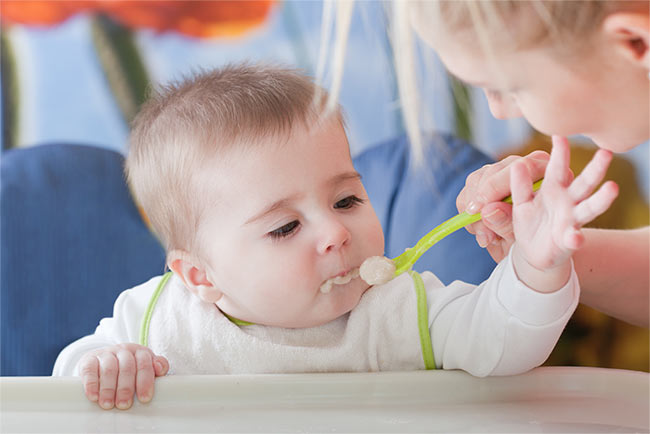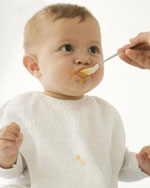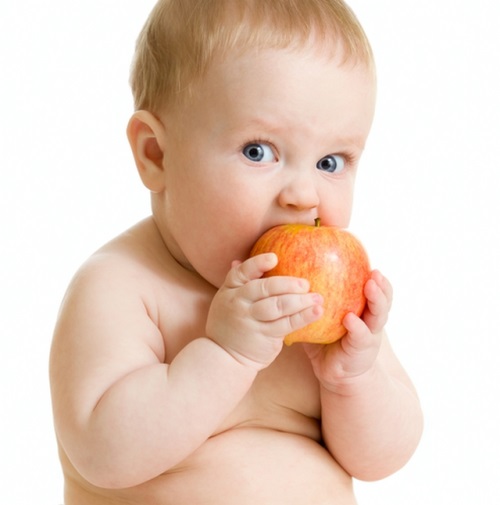First lure: when, what, and how much?

Breast milk is the best food for a baby. But gradually the baby needs additional nutrients, vitamins and minerals. All these additional substances to the baby provide lure. When to introduce the first complementary food? What and in what quantities should the baby be given? Let's try to figure it out!
The opinion of pediatricians about the first complementary foods and the timing of its introduction has changed. If before doctors advised young mothers to introduce the first complementary food for 3-4 months, then modern pediatricians recommend not to start luring up to 4-6 months. This is because up to 4 monthsThe baby's gastrointestinal tract is not yet formed enough to absorb new types of food. In addition, all the baby's needs up to 4 months is quite satisfactory for mother's milk.
If the child is on artificial or mixed feeding, then lure start to enter in 4,5-5 months, and if on the breast - a little later, with 5.5-6months. Healthy children are offered fruit juices and mashed potatoes as the first food, then vegetable purees, then porridges, meat, dairy products, eggs, fish. If the child is not gaining weight badly, the first lure begins with cereals. It is best to consult a pediatrician who observes the child. Only a doctor will help correctly determine the sequence of introducing new products into the baby's diet.
A new product should be given to a child, starting with the minimum number ofi.e. not more than half a teaspoon. It is better, if the unfamiliar dish the kid will try in the morning, so mother will be easier to follow his reaction to a new product. It is better to give lure when the baby is hungry, for example, before breastfeeding, then he will be more willing to accept new food.
It is necessary to closely monitor the condition of the baby. Have allergic reactions manifested: rash, redness and peeling of the cheeks, loose stools, etc.? If everything is in order, then within the next 1-2 weeks you can gradually increase the amount of complementary foods, bringing it to the norm corresponding to the age of the child. At a time, no more than one new product is introduced, and only when the baby is completely used to one product, you can start to gradually introduce into the diet one more product.
Fruit or vegetable juices and purees for the baby can be bought in the store, and you can cook yourself. What is better for the child? Ready mashed potatoes and juices in jars are prepared industrially bythe strictest control, so you can not worry about their "naturalness" and usefulness. In addition, in the finished mashed potatoes or juices the maximum quantity of vitamins and minerals is preserved.
Home-made purees and juices from fruits or vegetables bought on the market,certainly, are natural. But no one can guarantee that these nitrates, pesticides or other harmful substances are not exceeded in these fruits. Therefore, it is better to prepare puree or juices for the baby to use fruits and berries from a personal plot and only those fruits or vegetables that correspond to the season. Prepare the juice can be both with the help of a juicer, and manually, squeezing the juice through a sterile gauze. To prepare mashed potatoes, the fruit is ground in a blender, the vegetables are first boiled in a small amount of water, and then ground. In vegetable purees you can add a few drops of vegetable oil and a little salt.


Instruments for the preparation of juices or purees must be kept in perfect cleanliness!
Kashi is better to start to enter after vegetable complementary foodsi.e. approximately in 1-2 months. The first porridge for a child should not contain gluten - a strong allergen, which is contained invegetable protein. Rice, corn, buckwheat do not contain this substance. Later you can introduce oatmeal and millet porridge into the baby's diet. Manna porridge is best given to a child not earlier than a year. At first, the porridge should be cooked on the water, gradually adding a little milk or butter in them.
Soluble cereals should be prepared strictly in accordance with the manufacturer's instructions and immediately before feeding the baby.
Not earlier than from 6 months, can be introduced into the diet of the child cottage cheese. The daily rate of this product is small - only50 g for a child at the age of one year. Cottage cheese can be cooked by yourself. Kefir or curdled milk, bifid, heated on low heat to almost boil, leave to cool. After transfer the mixture into a sieve, in order to glass the serum. In the finished curd, you can add fruit puree, so that the new dish is more like a child.
Meat in the diet of healthy children is administered no earlier than 8-9months. You need to start with those types of meat that are least allergenic: rabbit, turkey, horse meat. If the baby does not have intolerance to cow's protein, then you can give him veal or beef. Meat for the baby is cleaned of fat, films, cartilage and tendons, cooked and twice passed through a meat grinder. To the meat add a little vegetable broth or puree. Meat broth should not be given to children.
Chicken eggs may cause an allergy, so startacquaintance of the kid with this kind of product is better with quail eggs. Begin lure with 1/8 of the yolk, gradually bring it to 1/2. For the preparation of complementary eggs, you should thoroughly wash, boil and clean the yolks from the proteins. To the kid it is better to offer an internal part of a yolk which did not adjoin to a protein. The yolk is ground and added to vegetable puree or bred with breast milk.
Fish can be given to a child from 10 months. It is better to start with low-fat species: cod, pollock, zander. If the baby does not have allergy on the fish, then the meat dish can be replaced by meat 1-2 times a week.
When a child gets acquainted with new types of food for him, they may not like him. If the baby refuses to eat a new dish, then do not insist. You can offer him this food later, after 2-3 weeks, because kids often change their tastes.














